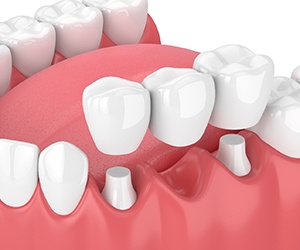







According to the American Academy of Prosthodontists, an estimated 140 million Americans suffer from tooth loss. If you’re part of that statistic, you know from experience how much it can affect your overall quality of life. Having gaps in your smile can make it difficult to perform simple tasks like eating and talking. Fortunately, we offer a high-quality tooth-replacement solution that’ll allow you to regain the full function of your teeth – dental bridges in Portland! To learn more about this restorative treatment, continue reading or give our office a call today.

Dental bridges are custom-made prosthetics fabricated from natural-looking materials, such as ceramic and porcelain. Since they’re color-matched to your enamel, the restoration will blend seamlessly with your smile. No one will be able to tell you have a dental bridge in your mouth! A dental bridge permanently restores your bite and helps you maintain a youthful face shape. It’s a great option for patients missing one or more teeth.

During your consultation, Dr. McInnis will perform a detailed examination of your mouth to determine which type of dental bridge is right for you. Based on her findings, she’ll recommend one of the following options:
A traditional dental bridge is the most common solution for replacing one or more consecutive missing teeth. The prosthetic teeth are secured in place by two dental crowns, completing your smile. It’s worth noting that this option requires the alteration of your natural healthy teeth.
Instead of dental crowns, this option uses dental implants to anchor your bridge into place. Each titanium post is surgically inserted into the jawbone on either side of the gap. Over time, they’ll naturally integrate with the surrounding bone tissue. One significant advantage of implant bridges is that they don’t require alterations to your natural teeth.

Are you thinking about replacing your missing teeth with dental bridges in Portland? Let’s take a look at some incredible benefits you’ll be able to appreciate:
No, you cannot take your dental bridge out, as it was designed to stay firmly in place in your mouth for many years. You should not be able to remove it on your own; only Dr. McInnis can remove it for you.
You may have heard a healthcare provider call a partial denture a “removable bridge,” but this is not an entirely accurate name. Partial dentures are similar to bridges, but one of the main differences is that partials can be removed by the patient at any time, while bridges cannot.
Before preparing your teeth to support your bridge, Dr. McInnis will numb the teeth she will be working with. Typically, all you need is a topical anesthetic, but severely nervous or anxious patients may benefit from nitrous oxide sedation.
Once your bridge is placed, your underlying teeth may feel sensitive for the next few days. You can take an over-the-counter pain reliever like ibuprofen or acetaminophen to help, however if your pain worsens, please call Dr. McInnis as soon as possible.
Because your bridge is designed to keep your remaining teeth from drifting out of place, it may prevent future discomfort caused by dental drift.
If you are getting an implant bridge, you will likely experience some soreness after the procedure; however, you will be provided with aftercare instructions that should help minimize the pain.
Depending on your individual needs, your dental bridge can replace anywhere from one to four consecutive missing teeth. However, in most cases, bridges will only replace one or two teeth. This is because the longer the bridge, the less stable it can become, especially if your natural teeth supporting it aren’t strong and healthy.
An implant bridge can lower this risk, as dental implants are just as strong and secure (if not stronger) than your natural teeth.
While technically it is impossible for a bridge to get cavities, your natural, underlying teeth still can. This can happen when food debris gets trapped underneath the pontics or in the space where the crowns meet the gums, attracting dangerous bacteria that could cause cavities or gum infection.
This type of issue is more likely to occur if you have poor oral hygiene, which is why it is essential that you clean under and around your bridge on a daily basis.
If your bridge is nearing the end of its lifespan, the cement holding it in place could begin to crack, allowing bacteria to enter the crevices and leading to infection or decay in the underlying teeth.